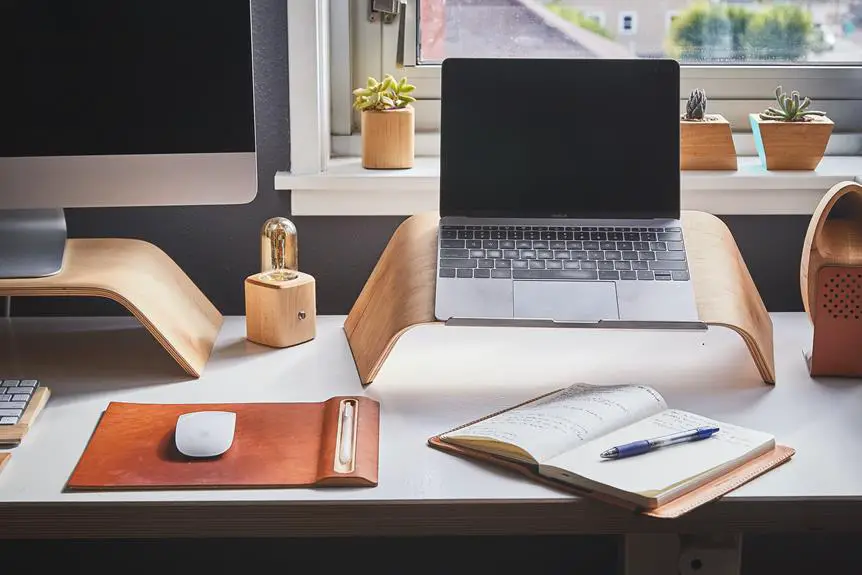You're in the middle of a virtual meeting, discussing a crucial project with your team, when the doorbell rings. It's a package delivery, and you have to sign for it.
As a professional working from a home office, managing work interruptions is a constant challenge. In a world where distractions are just a few steps away, finding effective strategies to stay focused and productive is essential.
So, how can you navigate these interruptions without sacrificing the quality of your work or your sanity?
Key Takeaways
- Setting boundaries and communicating expectations are crucial for managing work interruptions in a home office.
- Time management techniques, such as the Pomodoro Technique, can help increase productivity and minimize interruptions.
- Creating a distraction-free workspace through organization and optimization can minimize external disruptions.
- Managing unexpected interruptions requires clear boundaries, prioritization, and effective communication strategies.
Setting Boundaries
To manage work interruptions effectively in a home office, you need to set clear boundaries. Setting limits is crucial to maintaining a healthy work-life balance and avoiding burnout. Start by establishing designated work hours. Communicate these hours to your household, and stick to them as much as possible. This will help you create a routine and train those around you to respect your work time.
Create a physical workspace within your home that's solely dedicated to work. This will mentally prepare you for the tasks at hand and signal to others that when you're in this space, you aren't to be disturbed unless absolutely necessary. When your work hours are over, leave this space to signify the end of the workday.
Additionally, set boundaries with your digital devices. Constant notifications can be a significant source of interruptions. Consider silencing non-essential notifications during work hours or allocating specific times to check and respond to messages. This will allow you to focus on the task at hand without distractions.
Lastly, learn to say no. Whether it's taking on extra projects or agreeing to non-urgent tasks during your work hours, it's important to recognize your limits and prioritize your workload. By setting clear boundaries and sticking to them, you can create a more productive and sustainable work environment in your home office.
Time Management Techniques
Consider implementing the Pomodoro Technique to improve your time management skills in your home office. This technique involves working for 25 minutes, then taking a 5-minute break. After completing four cycles, take a longer break of 15-30 minutes. This method can help you stay focused and productive while also preventing burnout.
To further enhance your time management, it's essential to prioritize tasks. Start your day by identifying the most critical tasks that need to be completed. By focusing on these high-priority tasks first, you can ensure that the most important work is accomplished, even if unexpected interruptions occur.
Another key time management technique to consider is avoiding multitasking. While it may seem like multitasking can increase productivity, it often leads to reduced efficiency and lower quality work. Instead of trying to juggle multiple tasks at once, concentrate on one task at a time. This approach allows you to give your full attention to each task, leading to better results and a more efficient use of your time.
In addition to these techniques, setting specific time blocks for different types of work can also help you manage your time effectively. Designating specific time slots for activities like checking emails, making phone calls, and focused project work can prevent these tasks from encroaching on one another, leading to a more organized and productive workday.
Creating a Distraction-Free Workspace
Creating a distraction-free workspace requires intentional organization and a commitment to minimizing potential disruptions.
Start by optimizing your physical environment. Noise control is critical for concentration, so consider investing in noise-canceling headphones or soundproofing your workspace. Keep your workspace organized and clutter-free to minimize visual distractions. Clear off your desk, file away papers, and keep only essential items within arm's reach. Additionally, consider implementing productivity tips such as setting specific work hours and communicating boundaries to household members.
Concentration strategies are also essential for creating a distraction-free workspace. Utilize techniques like the Pomodoro method, where you work for 25 minutes and then take a 5-minute break, to maintain focus and avoid burnout. Another strategy is to designate specific tasks to specific times of the day, allowing your mind to anticipate and prepare for these focused work periods.
Moreover, consider creating a designated workspace separate from areas associated with relaxation or leisure. This physical separation can help signal to your brain that it's time to work, enhancing concentration and minimizing distractions.
Communicating Expectations
When setting expectations for your work environment, clearly communicate your needs and boundaries to those sharing your space. This is vital for creating a productive home office environment.
Here are some key points to consider when communicating your expectations:
- Setting Priorities: Clearly communicate your work schedule and the times when you need uninterrupted focus. This will help others understand when it's acceptable to approach you and when they should avoid interrupting you.
- Team Communication: If you're part of a remote team, make sure to communicate your availability and preferred communication channels. This will help your team members understand when you're accessible for meetings, discussions, or quick questions.
- Respect for Boundaries: Communicate the importance of respecting your workspace and time. Let others know that when you're in your designated work area, you should only be interrupted for urgent matters.
Managing Unexpected Interruptions
To effectively manage unexpected interruptions while working in a home office, it's important to establish clear boundaries and communication strategies. Prioritizing tasks is essential when unexpected interruptions occur. When an interruption arises, quickly assess its urgency and impact on your work. If it's a minor issue, politely ask if it can wait until later or schedule a specific time to address it. If the interruption is urgent, inform the person that you'll get back to them as soon as possible. Setting these boundaries will help you maintain focus and productivity.
Handling emergencies requires a flexible approach. Have a plan in place for such situations, and communicate it to those who may need to know. For example, if you have young children at home, ensure that they understand what to do in case of an emergency that requires your immediate attention. Additionally, consider having backup plans for urgent work matters. This could involve having a trusted colleague who can step in if you're unavailable for a short period.
It's also important to communicate your availability to others. If you have specific times when you can't be interrupted, make this known to family members, housemates, or anyone else who might inadvertently disrupt your work. Utilize tools like 'Do Not Disturb' settings on your devices to minimize unnecessary interruptions during focused work periods.
Frequently Asked Questions
How Can I Handle Interruptions From My Pets or Family Members While Working in a Home Office?
To handle interruptions from pets or family members while working in a home office, set clear boundaries and expectations. Communicate your work schedule, use visual cues like closed doors, and designate specific times for breaks and interactions to minimize disruptions.
What Are Some Strategies for Dealing With Technology-Related Interruptions, Such as Constant Email Notifications or Social Media Distractions?
Cut through digital noise by treating tech distractions like a leaky faucet – fix it! Mute non-essential notifications, set specific work hours, and communicate boundaries to minimize interruptions. Stay focused and reclaim productivity.
Is It Possible to Set Boundaries With Clients or Colleagues Who May Not Understand the Challenges of Working From a Home Office?
Setting boundaries with clients is crucial for managing interruptions. Communicate your work hours clearly and stick to them. Use tools like email auto-replies to manage expectations. Be firm but polite in explaining the challenges of a home office.
How Can I Effectively Communicate My Work Schedule and Availability to Others in My Household to Minimize Interruptions?
To minimize interruptions, set clear expectations and boundaries with your household. Communicate your work schedule and availability, and use a designated workspace. Establish signals for when you can and cannot be disturbed to maintain productivity.
What Are Some Techniques for Managing Personal Interruptions, Such as Taking Care of Household Chores or Running Errands During Work Hours?
To manage personal interruptions during work hours, prioritize tasks and manage time effectively. Set boundaries and create a routine to separate work and personal tasks. This will help you stay focused and maintain productivity throughout the day.




